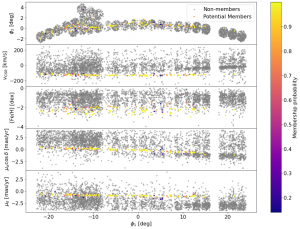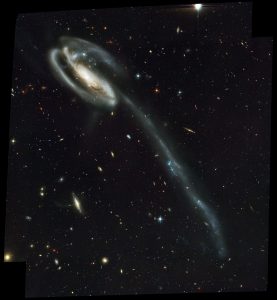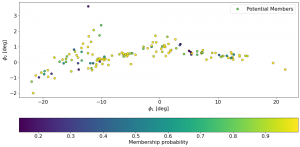Andrew is in his fourth year of undergraduate studies at the University of Toronto, specializing in Astronomy and Physics as well as completing a major in mathematics. He was born in Toronto, and moved to Calgary when he was two, but returned in 2020 to pursue his interest in physics at UofT.
In his spare time, Andrew loves playing guitar or reading a book in bed. This past summer, Andrew worked with Professor Ting Li and Dr. Gustavo Medina in finding stellar stream members.
What made you decide to participate in SURP?
I applied to SURP because I was itching to apply all the knowledge I had learned in the past few years to some meaningful research. When I saw the long list of incredible projects available to undergraduate students, I jumped at the opportunity to participate. I hoped to gain a lot of research experience and make contributions to the amazing field of astronomy.
Can you tell us about your research project?
The main goal of my research was to identify members of stellar streams using a different method. Stellar streams are these old structures that formed not long after the universe, and many remain far away in the outer halo of the Milky Way. Characterizing these streams can tell us a lot about the history of the Milky Way and the effect that dark matter had in its formation. I am using Bayesian statistics to separate stellar populations by considering various properties of the observed stars. This has proven to be a quick and effective way of finding stream members, and as of this summer I have characterized over 30 potential stellar streams!
What is your favourite thing about SURP?
SURP has given me a glimpse into the life of a researcher. I had so much fun learning about various topics to a degree not reached in our undergraduate classes. There were also many group meetings where I could interact with both fellow student researchers and experts in the field. I really felt like I learned a lot and also made a difference with the work I had completed. A big thanks to my supervisors for all of their guidance!
Can you explain how SURP has been different from your undergrad work?
My experience this summer has been vastly different from my undergraduate studies. I was able to go so much more in depth into a topic that was interesting to me, and it was exciting to be part of the process of finding answers to unknown questions. Unlike the practical assignments in our classes, there was a lot more flexibility and our results were a lot more fascinating. Discussing my new findings with my supervisor and other experts was a highlight of my experience this summer.

Potential members found in the ATLAS Aliqa-Uma stellar stream. The spatial plot is in the top panel. The members were found by separating a population that had similar trends in radial velocity, metallicity, and proper motion. Credit: Andrew Li.
What are your plans for the future?
After completing my undergraduate degree, I hope to continue on to grad school and hopefully become a researcher myself one day. I have really found an interest in galactic archaeology and dark matter this summer, and I hope I can continue learning about them for many more years to come!
The Dunlap Institute for Astronomy and Astrophysics at the University of Toronto is an endowed research institute with over 80 faculty, postdocs, students, and staff, dedicated to innovative technology, ground-breaking research, world-class training, and public engagement.
The research themes of its faculty and Dunlap Fellows span the Universe and include: optical, infrared and radio instrumentation, Dark Energy, large-scale structure, the Cosmic Microwave Background, the interstellar medium, galaxy evolution, cosmic magnetism, and time-domain science.
The Dunlap Institute, the David A. Dunlap of Astronomy and Astrophysics, and other researchers across the University of Toronto’s three campuses together comprise the leading concentration of astronomers in Canada, at the leading research university in the country.
The Dunlap Institute is committed to making its science, training, and public outreach activities productive and enjoyable for everyone of all backgrounds and identities.



